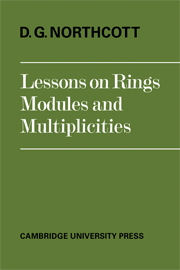Book contents
- Frontmatter
- Contents
- Preface
- Some notes for the reader
- 1 Introduction to some basic ideas
- 2 Prime ideals and primary submodules
- 3 Rings and modules of fractions
- 4 Noetherian rings and modules
- 5 The theory of grade
- 6 Hilbert rings and the Zeros Theorem
- 7 Multiplicity theory
- 8 The Koszul complex
- 9 Filtered rings and modules
- Index
4 - Noetherian rings and modules
Published online by Cambridge University Press: 09 January 2010
- Frontmatter
- Contents
- Preface
- Some notes for the reader
- 1 Introduction to some basic ideas
- 2 Prime ideals and primary submodules
- 3 Rings and modules of fractions
- 4 Noetherian rings and modules
- 5 The theory of grade
- 6 Hilbert rings and the Zeros Theorem
- 7 Multiplicity theory
- 8 The Koszul complex
- 9 Filtered rings and modules
- Index
Summary
General remarks. This chapter contains a detailed study of Noetherian modules that is of modules which satisfy the maximal condition for submodules. We continue to suppose (for the duration of Chapter 4) that all rings under consideration are commutative and possess identity elements. However, the reader should note that each of the results proved in section (4.1) holds for any ring with an identity element even if it is not commutative. Indeed, the proofs given are valid in the more general situation just as they stand. To make this quite precise, we should add that, when employing the wider interpretation, the terms ‘R-module’ and ‘ideal’ should be taken to mean ‘left R-module’ and ‘left ideal’ respectively. Null rings are not excluded from the discussion.
Further consideration of the maximal and minimal conditions
Let R be a ring and E an R-module. In section (1.8) we explained what was meant by the statement that E satisfies the maximal or minimal condition for submodules. We shall now examine, in greater detail than before, the implications of these conditions. Of course, a substantial number of results in this direction have already been derived. However, as these are scattered among the pages of the preceding chapters, we shall restate certain of them in order to have related results grouped close together. Naturally the proofs of earlier results will not be repeated.
Lemma 1.Let 0→ E′ → E & E″ →0 be an exact sequence of R-modules. If E satisfies the maximal condition for submodules, then so do E′ and E″. Conversely, if E′ and E″ both satisfy the maximal condition for submodules, then E satisfies the condition as well.
Information
- Type
- Chapter
- Information
- Lessons on Rings, Modules and Multiplicities , pp. 175 - 234Publisher: Cambridge University PressPrint publication year: 1968
